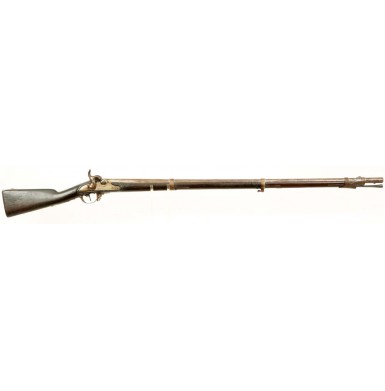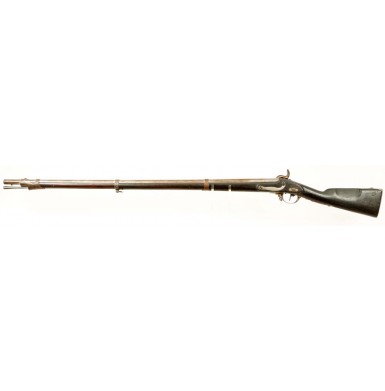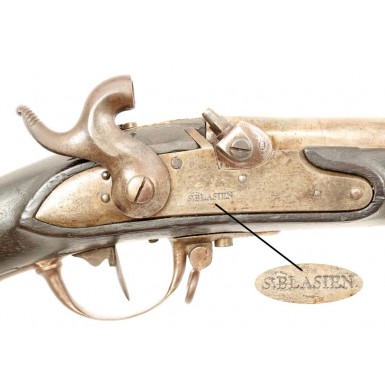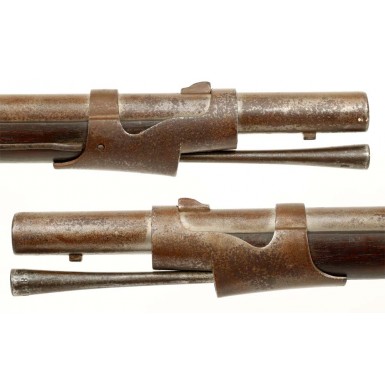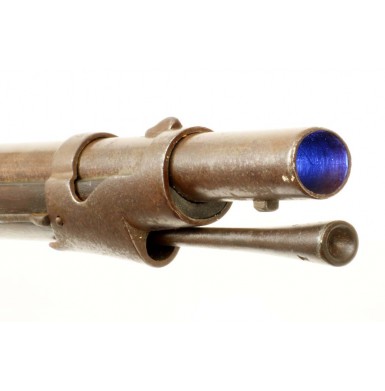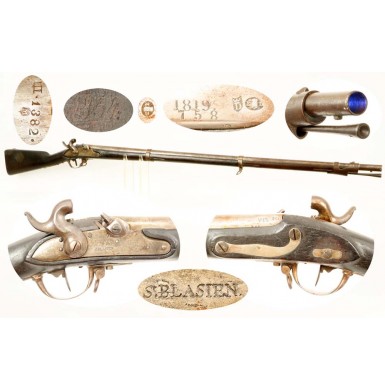This is one of those rarely encountered Civil War era European import muskets that has been misidentified since the American Civil War! Known to collectors as the “Württemberg” Conversion Musket, due in part to the semi illegible handwriting of US purchasing agent Marcellus Hartley, the gun should really be known as the Baden Conversion Musket. The State of Baden, was one of the many Germanic states that were eventually unified as a part of the German Empire in 1871. When the Holy Roman Empire dissolved in the early 1800s, Baden emerged as a Grand Duchy and it retained that title until it joined the Weimar Republic in 1918. The modern state of Baden-Württemberg was not established until 1952. During the 19th century, the Grand Duchy of Baden maintained an arsenal and arms manufactory in the Black Forrest, in the former abbey at St. Blasien. From time to time, arms are encountered with the marking S. BLASIEN on their locks, indicating that they were manufactured, altered or repaired at that facility. The armory produced a variety of arms during the 19th century, most of which were heavily influenced by French arms of the era. In fact St. Blasien often utilized French parts and even altered French made arms from flint to percussion. This is the source for the arms known as Württemberg Conversion Muskets by today’s collectors. During the 1850s the arsenal altered a number of obsolete French Model 1816 and Model 1822 muskets from flint to percussion. Some of these arms retained nearly all of their original French parts, with the only new parts being a St. Blasien percussion bolster, percussion hammer, and in some cases a newly added rear sight. Many of the muskets were also rifled at the arsenal as part of the alteration process. Several different patterns of rear sights were utilized on the guns that were rifled during the alteration process, with a simple block sight dovetailed into the top of the breech being most common, but various patterns of long range French tangent sights were also used. These altered muskets only saw use in Baden for a limited time, as the large bore muzzle loading arms were already obsolete and the Prussian developed Dreyse needle gun of the previous decade was already sounding the death knell for all muzzle loading military arms. With the coming of the American Civil War, and the desperate need for long arms by both sides, a veritable army of northern and southern buyers descended upon the arms making centers of London, Birmingham, Li’ge and Vienna, as well as in a score of other smaller continental cities. Marcellus Hartley was one of the primary agents working on behalf of the US Ordnance Department, as well as on his own behalf as a principle in the large New York based military arms and equipment dealer Schuyler, Hartley & Graham. Hartley had extensive connections to the arms trade in England and across Europe due to his pre-war business in retailing weapons and military gear. In addition to purchasing arms for the use of the Union, Hartley was also empowered to purchase arms specifically to keep them from falling into southern hands. This may explain why Hartley purchased so many low quality, obsolete arms in questionable condition. His goal may not have been to arm the Union with these guns, but to simply keep the Confederacy from buying them. Interestingly the Confederacy had no particular interest in acquiring European cast-off weapons and concentrated on buying English Enfields and, if necessary, Austrian Lorenz rifle musket, and southern buyers were directed to avoid purchasing low quality, obsolete muskets. Hartley notes in a letter dated 16 October 1862 that while in Li’ge he purchased “from B.M. Tambeur Frères 2,000 Untembery government guns, rifles with sights, implements, cones and packing boxes at 40 francs.” Most researchers believe that “Untembery” was Hartley’s corruptive spelling and bad handwriting attempt at the name “Württemberg”. The same letter notes that over the last few weeks, exclusive of “Enfields”, Hartley has contracted for the purchase of some 96,000 guns, including 30,000 muskets in Vienna, 30,000 in Berlin, had contracted for 18,500 in Li’ge previously and including the guns mentioned above had contracted for another 17,500 in Li’ge that very day. He also notes that the additional 20,000 Prussian guns that he had previously considered buying would not be purchased now, “as those purchased here are superior and will be ready for use at once.” It is also interesting to note that many of the guns he had contracted for are mentioned as being smoothbore and without sights. His letter states “These last 15,000 are government guns, smooth bore, but they will be rifled; 5,000 is all I can have sights put on.” Amazingly only two sentences later he claims “They are all first-rate guns”, certainly a difficult assertion to make about smoothbore muskets of .69-.71 caliber that “will be rifled”, but only a third of which will receive sights! It is also somewhat mystifying to me that in the fall of 1862 the Union was still so short of usable arms that it was actively purchasing thousands of truly obsolete muskets. When trying to reconcile the “2,000 Untembery government guns’ against the known deliveries from Hartley’s contracts it is difficult to know if they are lumped in with the “15,000 Belgian Muskets @ $7.01 each” or the “19,688 French Muskets @ $8.47 (average price paid)”. It seems unlikely that they are part of the final total of “30,000 Prussian Muskets @ $6.80 each” that he delivered, as they are almost certainly M-1809 “Potsdam” muskets.
Offered hear is a relatively untouched and very crisp example of a “Württemberg” (Baden) Conversion Musket. Even though this example is an unsighted, smoothbore variant, it is still almost certainly one of the “2,000 Untembery government guns’ purchased by Hartley in the fall of 1862, and if not is one of Hartley’s other 3rd class musket acquisitions in Europe. The gun is in VERY GOOD+ to NEAR FINE condition. The gun started life as French M-1816 Flintlock Musket, and the very legible production date 1819 is visible on the left breech of the barrel, along with the French arsenal proof marks, including a (CROWN) / D, which I believe indicates that it was originally produced at the Charleville manufactory. The buttplate is marked with State of Baden regimental issue and rack marks, and reads: II . 1382 ., which probably indicates “2nd Regiment, gun #1382. A plethora of small inspection marks, mostly consisting of an M within a shield, are present on the musket in a variety of places. The French M-1816 was a nominally .708” smoothbore musket that remained in service for only a few years, being replaced rather quickly by the French M-1822 musket. The lock is clearly marked S. BLASIEN forward of the heavy percussion hammer, indicating that the alteration to percussion took place in the Black Forrest armory in Baden. The obverse butt stock is marked with a large acceptance mark and the year 1854, no doubt the year of alteration. The lock an excellent example of a St. Blasien re-worked French lock. The original French flintlock has been altered to percussion by removing all of the external and internal flintlock battery components, the extra holes have been filled and the exterior polished so nicely that it takes magnification and light to find the filled holes in the altered lock plate. The gun has the typical large St. Blasien bolster with an oversized clean-out screw, which has been brazed over the old flintlock touchhole. Interestingly, this gun was not rifled, and retains its original smooth bore, and has not added rear sight either. The musket has a thin, slightly mottled brown patina over a medium dark pewter gray base metal color. There are patches of the gun’s metal that are more deeply oxidized with a chocolate brown color. The majority of the metal remains quite smooth and shows only some lightly scattered pinpricking and some areas of lightly scattered pitting. There are also some patches of lightly oxidized surface roughness on the barrel and furniture, with the area around the muzzle and upper barrel band showing the largest and most obvious areas of surface scale. The bore of the musket is mostly bright and shows some lightly scattered pitting along its length, but remains in really FINE condition. The musket retains its original sling swivels, has no rear sight (as it was originally produced), and its original large iron bladed front sight. The original full-length ramrod is in the channel under the barrel, and it retains good threads at the end. The rod has the same nice brown patina as the rest of the gun. The ramrod is rack numbered 1852. That number does not match the rack number of the gun and is about 470 numbers off from this musket, but it the correct pattern and original rod for the gun. The lock functions crisply on all positions and is mechanically excellent. The original “State of Baden” cone (nipple) is no longer in the bolster of the musket, and a typical US type percussion cone is present. The cone is worn and shows erosion from use, indicating that it has probably been in the bolster since the time of use during the Civil War. The State of Baden cones were unusual, and have slots on either side for removal with a special screwdriver, rather than a conventional cone (nipple) wrench. The stock is in about VERY GOOD+ to NEAR FINE condition as well. It is full length and solid and is free of any breaks or repairs. The only real issue worth noting is a small sliver of wood out along the edge of the rammer channel, where wood often splinters off from the continual removal and insertion of the ramrod. The stock retains very good edges and lines and does not appear to have been sanded. The stock does show a significant number of bumps, dings, mars and scrapes, typical of a 19th century military musket.
Overall, this is one of those really cool guns that requires no excuses or explanations and that has survived essentially unmolested since the war. These unique alteration muskets served two continental armies (France & Baden) and then the US government during a service life of at almost 50 years! This a wonderful representative example of the many interesting European cast-off weapons that crossed the ocean to serve during the American Civil War, and would be a wonderful addition to your display of imported arms. With so few purchased during the war, this is an import arm missing from most advanced musket collection. In over 10 years this is only the 3rd one that I have had the pleasure to offer for sale, so don’t miss your chance at a rare and interesting musket at a very reasonable price. An very similar example of this rare import musket is pictured on page 116 of Firearms From Europe “ Second Edition
SOLDTags: Baden


